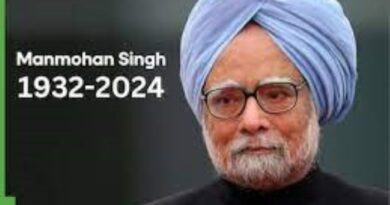Blowing the Trump-et. Needed: A Media nanny for our kids?
Needed: A Media nanny for our kids?
There was a time around 9 /11that the US Media set an unforgettable example. One the world and I will never forget. A collective decision was taken not to publish any images of the tragedy in view of the impact that they would have on young minds Save the iconic and tragic image of the falling man by Henry Singer, that has been captioned the most unforgettable image of the 9/11 tragedy, the world saw none of the blood and gore, the mutilated bodies, the severed limbs,
Henry Singer, the photographer who took that image, had this to say in an interview to Adam Harrison Levy in a later interview: “The Falling Man ran in many newspapers on the day after 9/11. There were so many images coming across the wire that day but this one stood out for her because it encapsulated the horror of the day. And yet at that paper, and across the country, there was an outcry from the readership saying how could you publish an image like this? This is offensive, our children could have looked at it, and a result the image basically disappeared from sight.” As photographer the decision to withdraw the image may have impacted Singer professionally, but around the world, the decision by the media to not run graphic images of the tragedy, to practice restraint and caution, lest the action leave a lasting negative impact on the future generations of America, commanded respect, including mine.
As a Media Educator, I have often cited this example with pride that encapsulates the best and the most ethical stands taken by the media, one that restores faith in all that is good and ethical about the Fourth Estate and respect for the US Media in an era of paid news and paparazzi. For me, it marked a turning point in an age of intense intrusion into people’s privacy, the bare-it-all trends that have dominated the media in recent times.
However, less than a decade on, I wonder where that sanity of mind, the balance in perspective and the vision of the long-term impact of salacious gossip on young impressionable minds has disappeared in that very US Media today?
The concern being voiced by news anchors across CNN and other international media houses hasn’t quite escaped me. The curvaceous skeletons falling out of President Trump’s rather expansive cupboards with unfailing regularity haven’t really been a surprise. US Presidents’ have a rather miserable track record of dalliances and indiscretions. Their affaires de Coeur are at best an embarrassment to parents and educators like me who expect a degree of decorum and self-restraint from people at large and especially those in public office.
A CNN poll states that 63% American women have said they believe in the women alleging Trump’s affairs. The fact that Stormy Daniels was paid off $130,000 as hush money just days before Trump announced his candidature for Presidency reflects rather negatively for the current POTUS. The similarities between the McDougal and Daniels’ stories are undeniable.
The exchange of consensual sex between consenting adults is not an issue that bothers me. What sickens me totally as a parent is the fact that Trump allegedly told both women they reminded him of his daughter. Whether that was before or after the act is inconsequential. The fact that he mentioned his daughter in the middle of physical intimacy with another woman is abhorrent. What kind of a pervert would do that?
What rattles me is the crumbling of faith of young adults in the highest public office in the United States of America. The impact it is likely to have on young teenagers already adversely impacted by over exposure to sexually explicit content on Mobile and Internet. A seminal research study commissioned in 2016 by the Australian Institute of Family Studies (AIFS) clearly defines the impact, exposure to and consumption of sexually explicit material has on children and young people. And I will try to outline some of its findings for concerned individuals like me—if there are any left—at the long-term aftershocks of such explicit salacious gossip on our future generation.
Adolescent Sexuality and Health:
The increase in exposure to sexually explicit material has been cited as a significant factor influencing adolescent sexuality and health. Published research demonstrates an association between exposure to sexual content and a variety of sex-related outcomes for adolescents. The increasing availability of pornography online has raised concerns about the impacts it may have on children and young people:
- knowledge of, and attitudes to, sex;
- sexual behaviors and practices;
- attitudes and behaviors regarding gender equality;
- behaviors and practices within their own intimate, sexual or romantic relationships; and
- risk of experiencing or perpetrating sexual violence
The USA implemented the Children’s Internet Protection Act 2000 in order to mediate children and young people’s engagement with explicit online material. The Act introduced strict filtering policies that required federally-funded schools and libraries to block online material inappropriate to children and young people under 17 years of age.
Youth Culture and Digital Culture
Developments in digital technologies—particularly as they have become more convergent, mobile and individualized—have affected changes in youth culture. Children and young adults use the Internet regularly and effectively their digital lives often complement their offline existence. The teen pregnancy rate is five times higher for young people in the US than that in the Netherlands, which has been noted as a symbol of unsuccessful interventions.
Over 37% of young people say their sex education classes at schools were unhelpful, and 75% favor more comprehensive sex education programs to prepare them for the real world and the online assault.
But who will protect them from the media blitzkrieg on the indiscretions of their own President/s?
Attitudes about Gender
There is evidence that exposure to such explicit sexual details about the indiscretions of people in public office can affect young people’s attitudes towards gender. In particular, it may produce an increased belief in gender stereotypes, especially sexual roles and ideas about women as sex objects, sexual double standards and rape myths for both boys and girls.
“Gender stereotypes” refer to traditional understandings of the appropriate roles of men and women and their relations; principally, that women are subordinate and men dominant. Thus the perception of sex as divorced from intimacy, loving affection and human connection.
Those children at an age or developmental level that are unaware of and uninterested in sexual activities may be more likely to find such unwanted exposure to gory details of their President’s carnal dalliances upsetting. For example, in a survey of 10–17 year olds in the USA, 10% described the experience of exposure to sexually explicit material or pornography as very or extremely upsetting.
In addition to age, gender reactions in young children’s experiences of sexually explicit content differ. Girls are more likely to find such imagery distressing, embarrassing, demeaning or disgusting, while boys are more likely to be sexually aroused by pornographic images.
Clinical symptoms of depression have been associated with minors exposed to and consuming sexually explicit content online as well as with those who have experienced unwanted exposure, as in the case of the details of the Clinton and Trump affairs. Pornography use has also been associated with decreased academic performance.
Sexual Riskiness
It has also been argued by social science researchers that the varied activities depicted in pornographies “may incite, eroticize and give legitimacy” to them increasing the likelihood of adolescents engaging in riskier sexual activities. Yet there are some important clarifications required in order to report on what constitutes sexually risky behavior and how these have been studied. This “sexual riskiness” refers to negative or unhealthy outcomes, that is, activities that lead to unwanted pregnancy or sexually transmitted infections (STIs including HIV).
In view of the above findings, is it not time for the media at large and the US media in specific, to practice the same restraint that we saw during 9/11? For this is another form of terrorism assaulting our young minds –one we need to shield them from. In the age of digital media deluge that may seem an impossible reality. “With great power, comes great responsibility,” a line from the popular superhero film Spiderman, draws my attention. However, the message of that seems to have been entirely missed by certain people in public office. The need for setting examples, maintaining high ethics and maintaining propriety and discretion in their public and private lives, is a chapter they seem to have skipped altogether. But, perhaps we, the stakeholders and guardians of the future of this vast land, as parents, guardians and educators need to sit up and take note. Future generations will thank us for it. For keeping their innocence alive for longer!




